Ata-ul-Haye Nasir and Tahmeed Ahmed, Ahmadiyya Archive & Research Centre
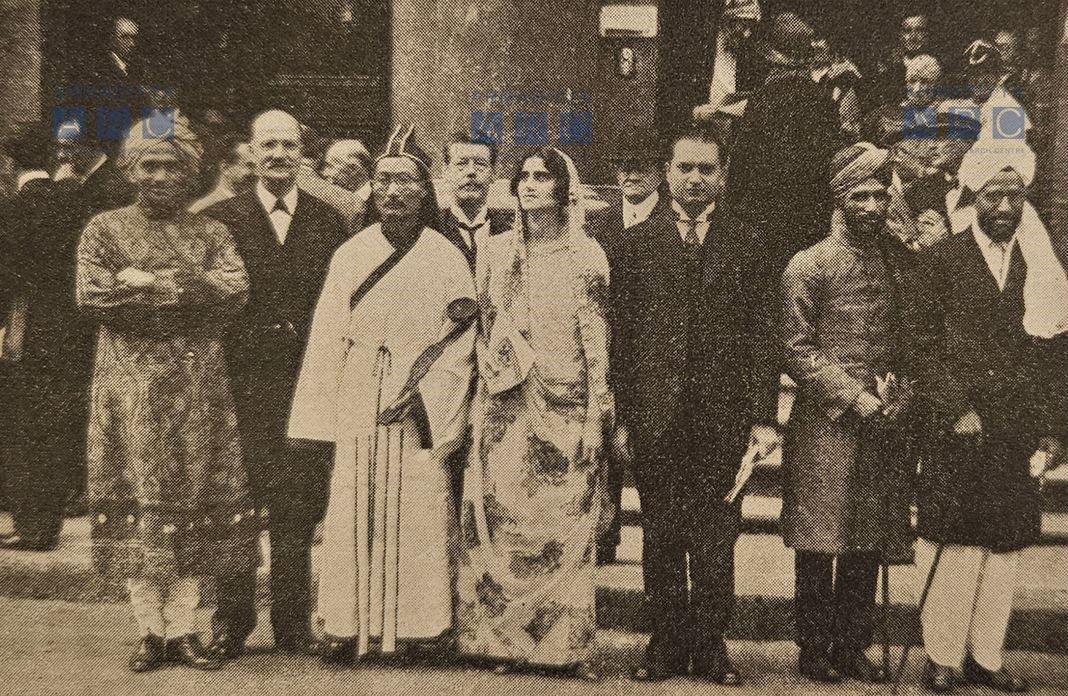
Religion has always been a topic of discussion. Whether one follows a faith or not, belief remains a vital part of every person’s life. It is a deep and personal aspect of our being, and one of the most effective ways to explore it is through reflection, dialogue and comparison.
Platforms for comparing religions have been numerous throughout history. Some famous examples include Akbar’s “House of Worship”, the 1893 “World’s Parliament of Religions” and the 1924 “Conference on Some Living Religions Within the Empire”. Their purpose remained the same: to present the core teachings of each religion on one stage, allowing their representatives to compare them and make their choice. Rather than fostering division, these events have shown that true comparison brings people closer together – for if we sincerely reflect, we will realise that all these rivers have flowed from the same source.
Religious conferences 1893-1928
In September 1893, the “World’s Parliament of Religions” was held as part of the World Columbian Exposition in Chicago, which was the first formal gathering of religious representatives of the Eastern and Western parts of the world.
This event, according to The Toronto Mail of 26 January 1894, marked “a distinct stage in the history of religion. There was never a time in all the past in which such a gathering could have taken place.”
Around two decades later, on the eve of World War I in 1914, Andrew Carnegie (1835-1919) of New York assembled a group of leaders in religion, academia and politics, and appointed them trustees of an organisation named the Church Peace Union – later The Carnegie Council for Ethics in International Affairs. Through this organisation, Carnegie hoped to make war obsolete.1

The end of the First World War marked a monumental moment in history, as the world slowly but surely began to move towards normality once again.
The 1924 Conference on Some Living Religions Within the Empire was a continuation of such endeavours and was graced with an address by Hazrat Musleh-e-Maud, Mirza Bashir-ud-Din Mahmud Ahmadra. This conference was convened at the Imperial Institute in London from 22 September to 3 October.
This was followed by multiple efforts to hold worldwide religious conferences, for instance, in the late 1920s, the Church Peace Union of America put forward the idea of the Universal Religious Peace Conference. Hazrat Maulvi Abdur Rahim Dardra – the then Imam of the Fazl Mosque – was a member of its Provisional Committee and represented Islam in the Preliminary Meeting in September 1928. The aim of this proposed conference was to gather representatives from all countries and all faiths to deal with those questions which affect human brotherhood and international concord.
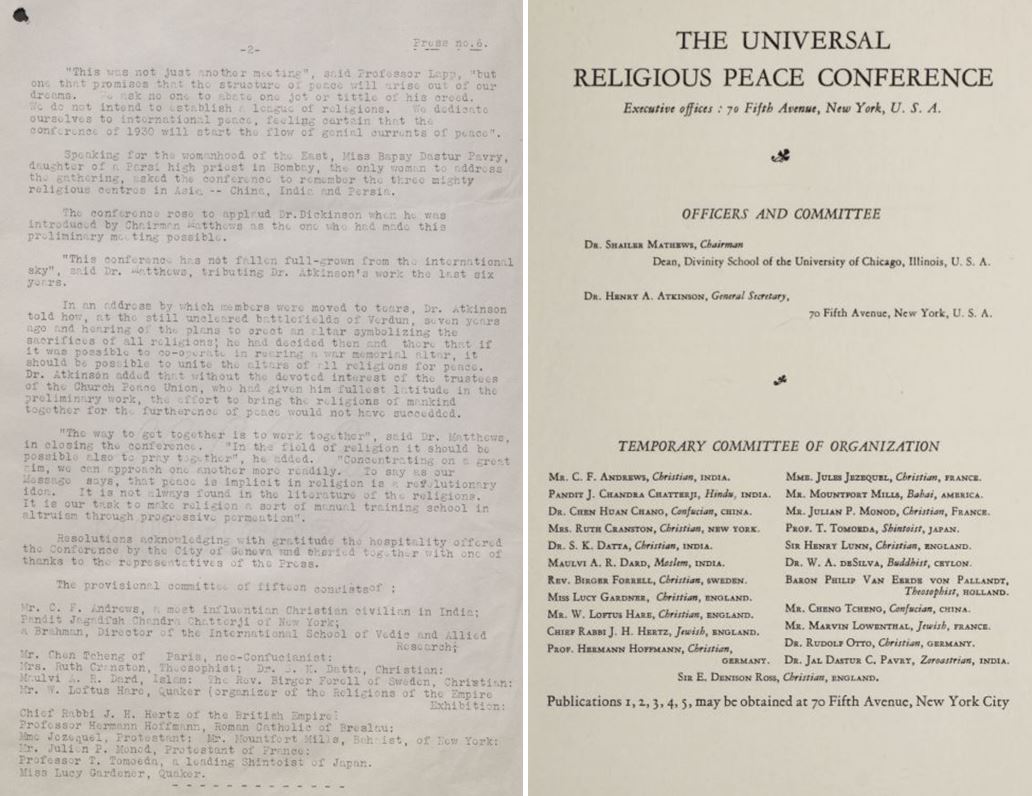
The Ahmadiyya Archive & Research Centre has been able to gather details of this proposed conference and the proceedings of its preliminary meeting, and this article aims to present a glimpse of it.
Proposal for the Universal Religious Peace Conference
The suggestion to hold an Universal Religious Peace Conference was proposed by the Trustees of the Church Peace Union in 1924. This organization, in its plans to enlist religious-minded people and organise them against war and for peace, came to recognise that if its work is to be effective it must include in its program all the religions of the world.2
An initial announcement was made in June 1925, which was widely circulated in the press. A Canadian newspaper reported under the heading “World Peace”:
“To study world peace from the viewpoint of the world’s eleven leading religions a congress is being planned by the Church Peace union, founded by Andrew Carnegie, to be held at Geneva in 1928 by 1,000 representatives of these religions. They will be Christians, Jews, Moslems, Buddhists, Confucianists, Shintoists, Taoists, Hindus, Parsees, Jains and Sikhs. The congress will last fifteen days. It will organize and hear keynote addresses the first two days and hear representatives of each religion talk on a separate day on the topic: ‘What can my religion contribute to International justice and goodwill?’ The languages spoken will be English, French and German.”3
The Jewish Criterion of 18 June 1926 and The Restoration Herald of September 1926 also announced the proposal of this conference.

Among the English press of that time, The Review of Religions represented the Ahmadiyya viewpoint globally. We find that in its June 1925 issue, it mentioned this proposed conference under the heading “Congress of Religions”, and wrote:
“For the purpose of bringing the combined influences of the world’s leading religious faiths to bear upon the problem of world peace, an International Religious Congress will be held at Geneva in August, 1928. The first announcement of the Congress was made today at the headquarters of the Church Peace Union following a meeting of the trustees of that organisation.”4
A French-language Swiss newspaper, Gazette de Lausanne of 22 February 1928, announced the Preliminary Meeting of this proposed conference under the heading “World Conference of Religions for Peace” and wrote that The Universal Religious Peace Conference is scheduled to convene on 12-14 September 1928 in Geneva “which will be a preliminary conference only to prepare a much larger event planned for the year 1930.”
The New York Herald Tribune of 17 June 1928 also wrote about this upcoming meeting and stated, “Sir Eric Drummond, of the League of Nations, expressed himself as keenly interested ‘in the definition of the questions the conference will discuss.’”
Maulvi A. R. Dardra
Hazrat Maulvi Abdur Rahim Dardra, commonly known as “Maulvi A. R. Dard”, was a missionary of the Ahmadiyya Muslim Community and the Imam of the London Mosque. The Church Peace Union invited him as the representative of Islam and also nominated him as a member of the Provisional Committee for this proposed conference. During the Preliminary Meeting of this Conference in September 1928, Maulvi A. R. Dardra delivered a speech, representing the Islamic teachings.
Invitation and official report to The League of Nations
The records held at The League of Nations suggest that on 15 August 1928, the General Secretary of the Universal Religious Peace Conference, Dr Henry A Atkinson sent an invitation to Sir Eric Drummond, Secretary-General of The League of Nations. Dr Atkinson also served as the Executive Secretary of the Church Peace Union from 1918 to 1955. He wrote:
“I have the honor to hand you herewith the programme for the Preliminary Conference in preparation for the Universal Religious Peace Conference, of which I had the pleasure of telling you some years ago. We plan to have a meeting of about eighty persons. Up to the present, we have acceptances from almost a hundred and representatives of every one of the world’s great religions. It promises to be an important and impressive gathering. We would be very happy indeed if, in the midst of your busy days, you could look in, if only for a few minutes, during our sessions.”5
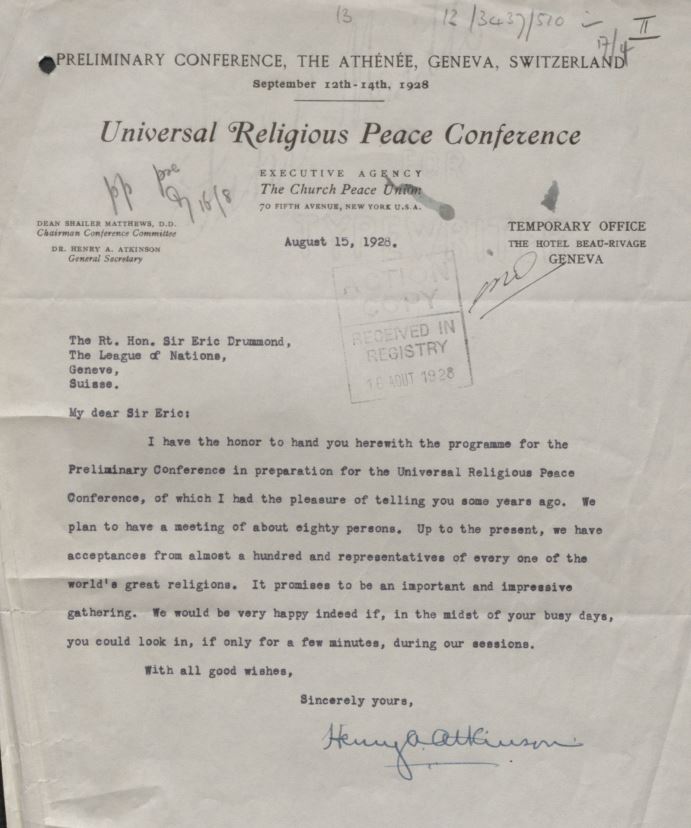
The Preliminary Meeting was convened in Geneva, Switzerland, on 12-14 September 1928. Thereafter, on 24 December 1928, the General Secretary of the Universal Religious Peace Conference sent a report of this meeting to the Secretary-General of the League. The covering letter from Dr Atkinson stated:
“I take pleasure in sending you herewith a pamphlet which gives the story of the remarkable preliminary conference held in Geneva, Switzerland, September 12 to 14, to make arrangements for calling a World Peace Conference of all religions in 1930.
“One hundred and ninety-one delegates were present, adherents of eleven religions. The speeches and discussions all showed a remarkable unanimity in ideals and teaching regarding universal brotherhood and peace.”6
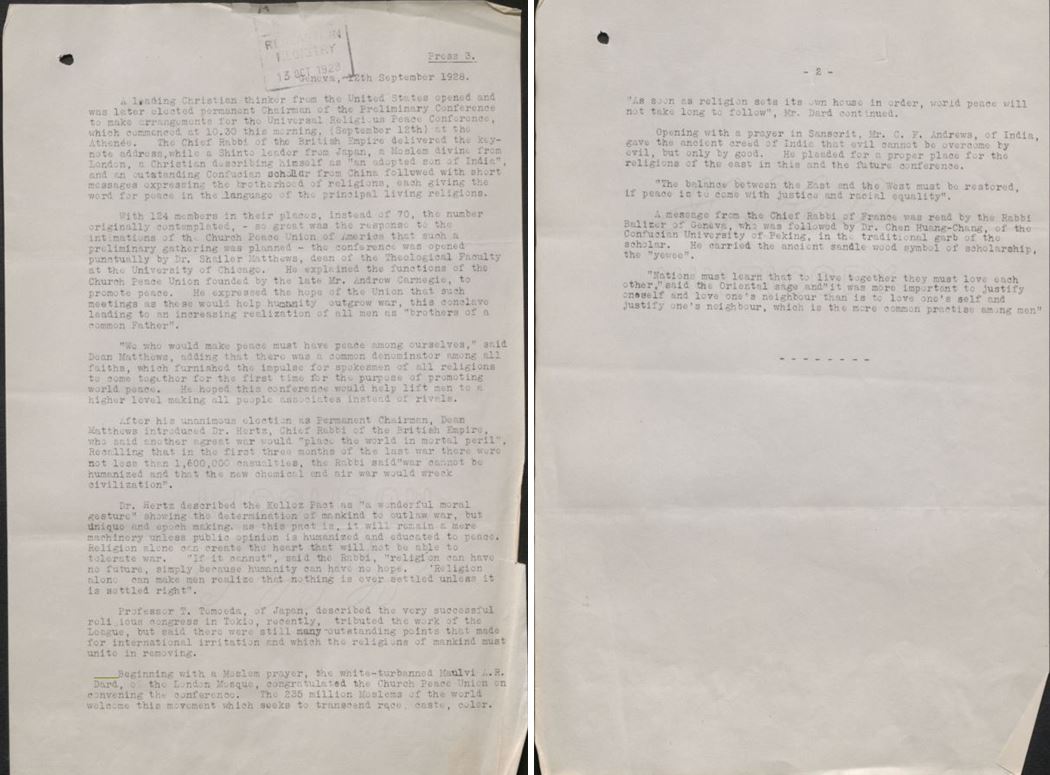
The report mentioned that “Maulvi A. R. Dard” participated in the meeting, “representing the Moslems.” Mentioning the speech by Hazrat Maulvi Abdur Rahim Dardra on 12 September 1928, the report wrote:
“Beginning with a Moslem prayer, the white-turbanned Maulvi A. R. Dard, of the London Mosque, congratulated the Church Peace Union on convening the conference. The 235 million Moslems of the world welcome this movement which seeks to transcend race, cast, color.
“‘As soon as religion sets its own house in order, world peace will not take long to follow”, Mr. Dard continued.”7
Narrating about the Preliminary Meeting’s proceedings, the Educational Secretary of the Church Peace Union, Rev Frederick Lynch, mentioned that “Mohammedanism was represented by Maulve A. R. Dard, one of the outstanding leaders of the Moslem world […].”8
Press coverage on the proceedings

A Swiss newspaper, Journal de Geneve – dated 13 September 1928 – reported on this meeting, under the heading “Preliminary Conference for the Organization of the Universal Congress of Religious Forces for Peace” and wrote that “a delegate from the London Mosque in a white turban, Maulvi A. R. Dard, who, before speaking, recited a religious cantilena.” The article expressed that the scene was “picturesque” as the attendees of this gathering also included “an Orthodox bishop” and “a Mohammedan in a turban”.
The same periodical, in its 14 September 1928 issue, published a short report of this meeting under the heading “Report of the First Committee” and stated that “the committee recommended that the congress should meet in 1930, the choice of the place being left to the executive committee, but it appears that an Eastern country will be chosen, in accordance with the wish expressed by the delegates from India.”
La Tribune de Geneve of 14 September 1928 also wrote that “Mr. Maulvi A. R. Dard, of the London Mosque, said that the 235 million Muslims welcomed the movement to eliminate differences of race, caste and colour.”
Feuille d’avis de Lausanne of 15 September 1928, published a photograph with the following caption:
“The Preliminary Meeting for the Organization of the Universal Congress of Religious Forces for Peace took place on Wednesday in the Salle de l’Athénée, Geneva.
“From left to right: Dr. Jal Pavry (son of the High Priest of Bombay); A. R. Dard, Imam of the London Mosque; Dr. Cheng-Huan-Chang of Peking, Miss Bapsy Pavry (daughter of the High Priest of Bombay); the Secretary of Dr and Miss Pavry; on the extreme right: Metropolitan Denis of the Orthodox Church of Warsaw.”
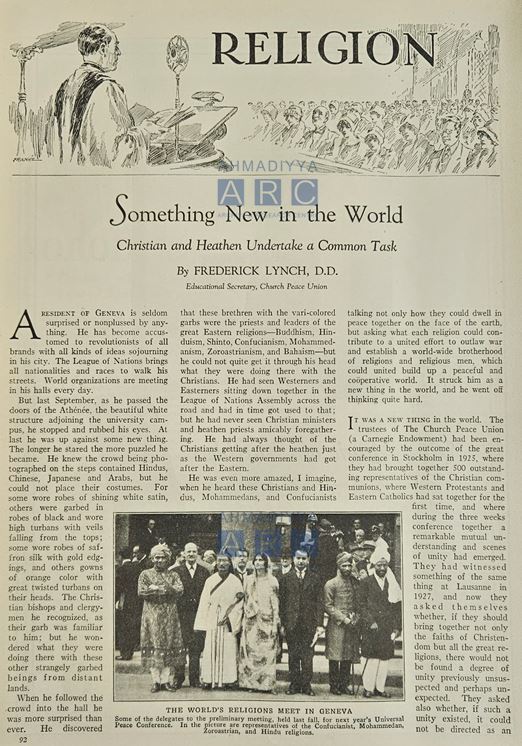
The same photograph was published by The Review of Reviews in June 1929.
This meeting caught considerable attention from the American and British press. For instance, a British newspaper, the Daily News and Westminster Gazette of 13 September 1928 wrote:
“Geneva, Wednesday – A preliminary conference to make arrangements for a universal religious peace conference opened here this morning under the presidency of Dean Shailer Mathews, of Chicago University. The speakers included Dr. J. Hertz, Chief Rabbi in the British Empire, London: Professor Tomoeda, Japan, representing the Shinto religion: Maulvi Daro [sic., Dard], of the London Mosque, representing the Moslem world […]. All spoke in favour of religious brotherhood and declared that it was for the religious mind of the world to prevent wars. Three committees were appointed to consider various aspects of the proposed conference.”
The Christian Register of 11 October 1928 also published a detailed report, along with a photograph.

A Finnish periodical, Församlingsbladet, mentioned this meeting in its 8 November 1928 issue and quoted Dard Sahib’sra speech. In December 1928, another Finnish periodical, Teosofin Joulu, mentioned this meeting and wrote that “among others, the Islamic missionary, A. R. Dard, the Hindu Chatterji, and the Confucian Chen Huan Chang had arrived there, and together with representatives and leaders of Christian churches, such as the Archbishop of Warsaw of the Greek Catholic Church, they negotiated about interfaith cooperation.”
An American newspaper, The Birmingham News of Alabama, dated 4 November 1928, wrote that “A. R. Dard, the Mohammendan, said: ‘I am convinced that 235,000,000 Moslems of the world will welcome this peace effort, which promises to transcend all consideration of race, religion, caste and color.’”
Transcript of Dard Sahib’s speech

The official records of this proposed conference have provided the complete transcript of the speech delivered by Hazrat Maulvi Abdur Rahim Dardra at the Preliminary Meeting. The record states:
“Maulvi A. R. Dard a Muslim of India, commenced his address with a prayer in Arabic: ‘We should worship God alone who is Love.’ Then he said, ‘I thank God for having been given the opportunity of attending this Conference. The Holy Quran prophesied 1300 years ago that a time was to come when such conferences on religion would be held, and it is a great pleasure for me to see that the same Word of God is being fulfilled now in a wonderful manner. I must congratulate the convenors of this Conference on their having been selected to be the instruments through which this prophecy should be fulfilled.
“‘The very word Islam, by which our faith is known, means peace. The name of our God is peace. Our daily Muslim greeting to one another, here and hereafter, is ‘Peace be on you.’ A Muslim is one, says the founder of Islam, who brings about and helps peace among mankind with all that lies in his power. The heaven promised to Muslims in the next world is an abode of peace. Hence it is the sacred duty of all the Muslims of the world, which number about 235 millions, to help and welcome the convening of this Religious Peace Conference. Islam, moreover, is an international religion. It transcends all barriers of caste, color and country. Muslims from all parts of the world gather together every year at its birthplace and pay homage to the God of Abraham, Moses and Jesus and of all the world. A king kneels humbly by the side of a beggar and a white man prostrates with a black man, for before God all are equal. After all we are all members of one and the same human family and our common denominator is God Himself. Let us, therefore, work for peace and let us not be satisfied unless and until it is fully realized.
“‘The sphere of politics is too narrow for the growing magnitude of the world. Politics imply compulsion in one form or another. It is no good compelling people from without. All such efforts are bound to result in failure. The political atmosphere of the world today seems to be surcharged with mistrust and suspicion and the great cauldron is seething with discontent and dissatisfaction. Side by side with the signing of the peace pacts preparations are secretly made by all nations for war. The deadliest weapons are invented for destruction. Religion has often been made a tool for the furtherance of political and economic ends. Religious differences themselves have in the past been the cause of much ill feeling and bitterness between peoples and nations. People have been ignoring, depreciating and attacking faiths other than their own, but never before in the history of the world has there been a determined attempt such as this to take a distinctly different attitude and bring about definite cooperation between groups of religions for the purpose of serving the humanity of all the world. Now is the time to come together and make a definite advance. Religion should set its own house in order. How can Moses be a Prince of peace, how can Mohammad be a Prince of peace, how can Jesus be a Prince of peace, how can Krishna be a Prince of peace, if we all continue to wrangle over our petty differences? Let us be reconciled to one another – not in mere tolerance, but love. The further we go from one another, the greater will be our distance from our Heavenly Father. Let us therefore come together and approach the centre of our faith, each in his own way, and as we come together the nearer we will be to God just in proportion as we are near to each other. The world needs peace; it is crying out again for a Prince of Peace. Let us listen to the Divine call and let us start our work together. May God help us.’”9
The details of the proceedings of this conference have also been narrated by its General Secretary – Dr Henry A Atkinson – in his book, titled The World’s Religions Against War.
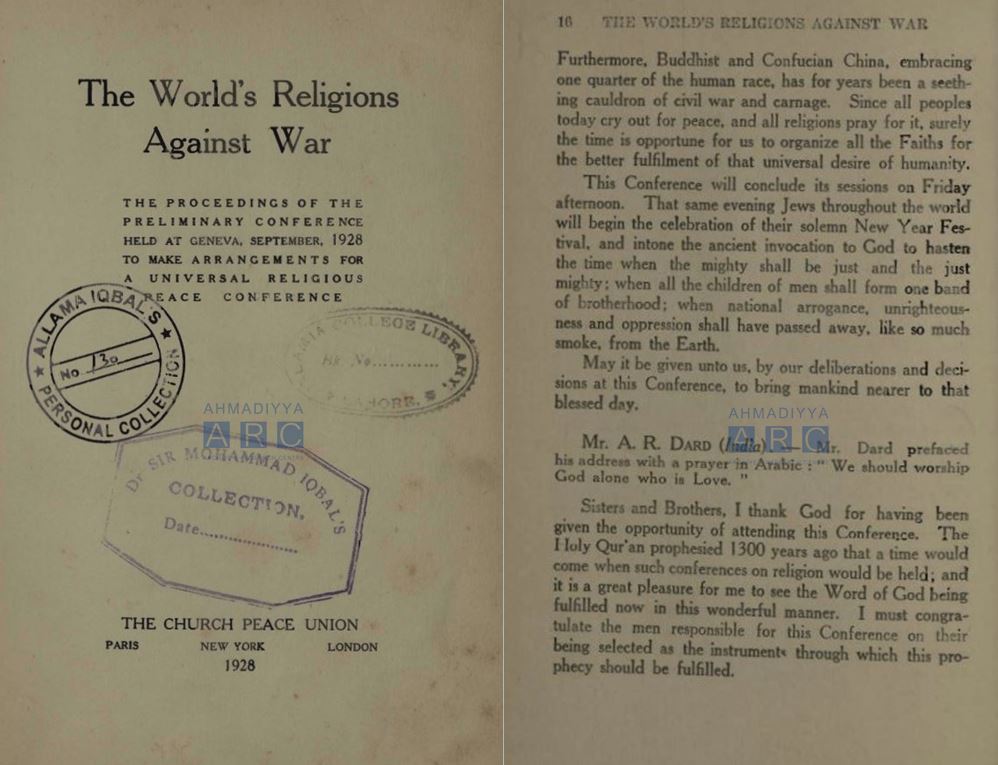
What happened to this Conference?
Later on, the Universal Religious Peace Conference was renamed as “World Conference for International Peace Through Religion”. The Executive Committee had further meetings: In Frankfurt in August 1929, in Berne in August 1930, in Geneva in August 1931 and again in Geneva in August 1932.
In the Berne meeting of 1930, it was decided that the religious conference would be held in Washington D.C. in November 1932. However, during the 1932 meeting at Geneva it was decided to postpone the idea. Elaborating on this, the official report stated:
“This plan has now been somewhat modified and the Executive Body of the World Conference for International Peace Through Religion is at present centering its attention more on organising national committees; in collecting data and materials which will be helpful to these national committees as well as to other bodies, such as the League of Nations, the International Labour Office, etc; and in promoting peace in such national and international areas where misunderstanding is rife. The plan, however, of holding a universal conference in Washington this year has now been postponed.”10
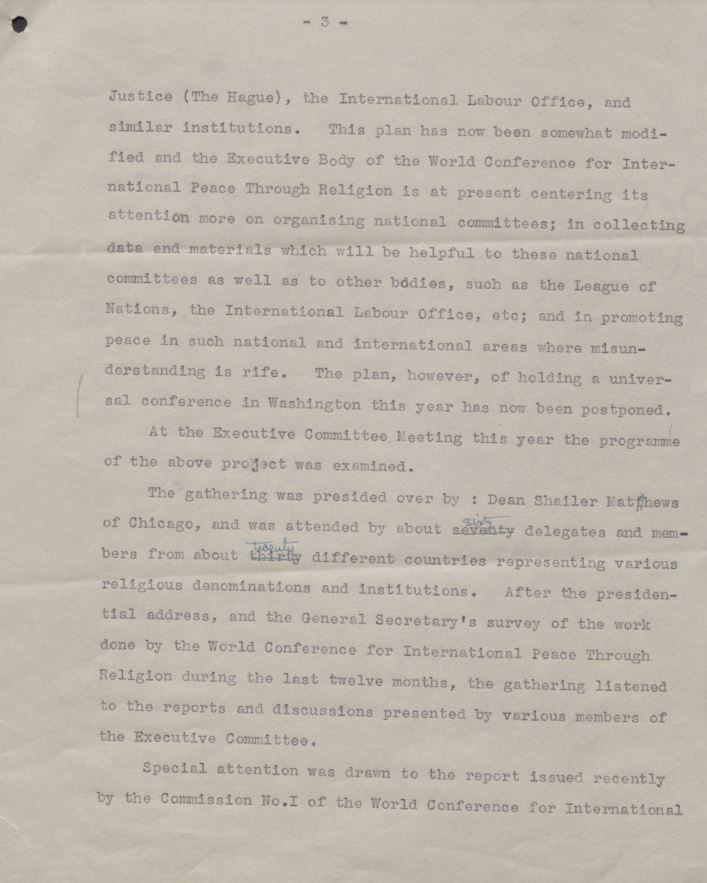
The Church Peace Union is now known as The Carnegie Council for Ethics in International Affairs. After World War II, the Church Peace Union highlighted the need for a World Congress of Religion. Hence, they proposed the conference to be held in October 1948, in Boston.
In 1947, the Educational Secretary of the Church Peace Union, A William Loos, narrated the history of their endeavours for world peace. He stated that the recent calls were “not a completely new venture on the part of the Church Peace Union. In 1925 a committee was set up to study the possibilities of holding a world conference of religious leaders. Preliminary meetings were held; and in 1928 a major conference was convened in Geneva, attended by 191 delegates who were adherents of eleven religious systems: Buddhism, Confucianism, Christianity, Islam, Shinto, Zoroastrianism, Bahaism, Theosophy, Ethical Culture, Judaism, and Hinduism.
“The tidal wave of reaction and repression that swept over the world in the 1930’s submerged the work. Following Mussolini came Hitler, and many a lesser dictator in other nations, all of them committed to an anti-democratic campaign of hate, intolerance, and brutality. Then came World War II and all plans for a World Congress had to be cancelled.
“Now, in this hectic period after World War II, we are faced with new symptoms of the old evils, which destroyed the League of Nations and threaten to make our century the bloodiest and most tragic in history. Our civilization can be saved, say the sponsors of this World Congress, if we are willing to use conscience and good sense.”11
He further wrote that “the Church Peace Union proposes to complete the task it undertook in 1928 by setting up a worldwide Committee of One Thousand, which will be recognized as the constituency of the Congress.”12
In 1948, the Church Peace Union organised the Conference of Religion for Moral and Spiritual Support of the United Nations13, where The World Alliance for International Friendship Through Religion was established to hold such religious conferences in the future. This organisation, in cooperation with the Church Peace Union, continued its endeavours in the years to come, however, this article does not intend to go into those details.
Endnotes
1. The New York Times, 12 February 1914, p. 8
2. The Geneva Preliminary Meeting of the Universal Religious Peace Conference, September, 1928
3. The Hamilton Spectator, 27 June 1925, p. 10
4. The Review of Religions, Vol. 24, No. 6, June 1925, p. 19
5. League of Nations Records, UNO Archives, “World Conference for International Peace Through Religion, Washington, November 1932”, Reference code: R3291/13/3437/510.
6. Ibid.
7. Ibid.
8. The Christian Union Quarterly, January 1929, Vol. XVIII, No. 3, p. 189
9. The Geneva Preliminary Meeting of the Universal Religious Peace Conference, September, 1928
10. League of Nations Records, UNO Archives, “World Conference for International Peace Through Religion, Washington, November 1932”, Reference code: R3291/13/3437/510.
11. The Witness, 16 October 1947, p. 9
12. Ibid.
13. Ibid., 16 December 1948, pp. 12-13

